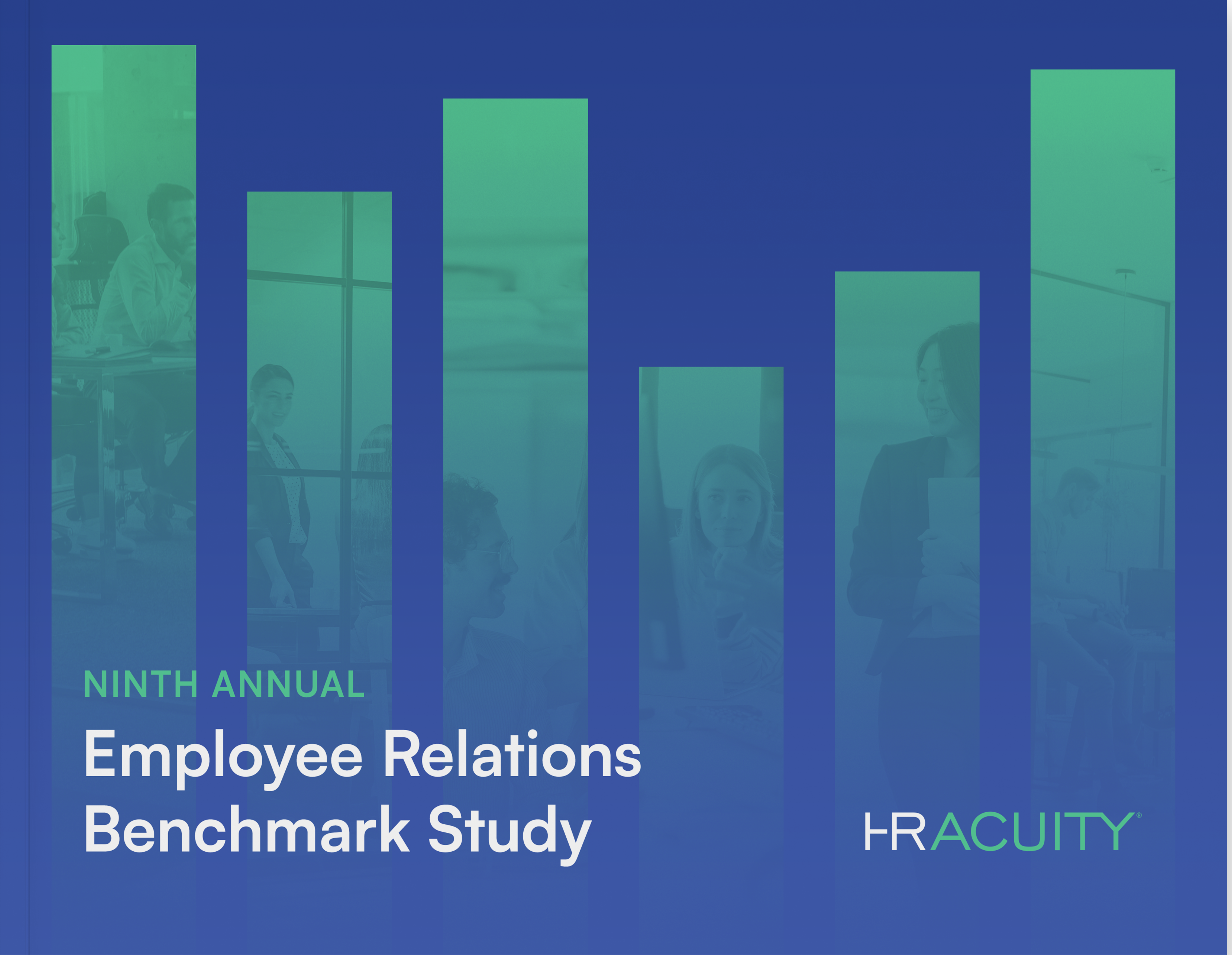Our Employee Relations Roundtable community of professionals met in the spring and one issue rose above the rest: mental health in the workplace. There were several questions: How can employee relations professionals best manage the challenge of mental health in today’s changing workplace? Are organizations prepared for a workplace crisis? How can ER professionals help struggling team members?
These are big questions, far too big for one blog article and there are no easy answers. Yet it’s essential that we as employee relations professionals have these dialogues. That’s why we dove into mental health challenges in this year’s Ninth Annual Employee Relations Benchmark Study.
I’m writing this article to share background, as well as 7 key steps we recommend when implementing practices related to mental health in the workplace. I’d like to hear your best practices, too. If you’re interested in sharing or authoring a piece, please email me at dmuller@hracuity.com.
We all deal with mental health issues in our day-to-day work as ER professionals, and we face our own mental health challenges. Depression, anxiety and stress are rampant. Consider these statistics:
- Anxiety and depression affect 264 million people worldwide and cost the global economy $1 trillion per year in lost productivity.
- One in 5 Americans suffers from a mental health condition – more than the populations of Florida and New York combined.
- As many as 80% of American workers report high levels of stress in their job.
The human impact is obviously huge, and there’s also a direct bottom line impact to businesses. The National Alliance of Mental Illness estimates that employers incur $100 billion in mental health-related costs each year, with 217 million lost workdays. Depression interferes with one’s ability to complete job-related tasks 20% of the time, and affects cognitive performance 35% of the time, according to the CDC.
Mental health also has a ripple effect and directly correlates to physical conditions such as heart disease, diabetes, asthma and substance abuse. The cost to treat those with both mental health disorders and physical disabilities is two to three times higher than those without these comorbid conditions. And, people with mental health conditions make six times as many visits to the ER and submit two to four times as many medical claims as the general population, according to the benefits consulting firm Willis Towers Watson.
That’s the bad news. The good news is that investing in mental health pays strong dividends. The World Health Organization estimates a $4 return in improved productivity and health for every $1 spent on the treatment of common mental health disorders.
There’s more good news too: Treatment works. While failure to support employees’ mental health comes at an emotional and financial cost, 80% of those who are treated for mental illness report improved satisfaction and efficiency, according to the American Psychiatric Association. Businesses benefit from lower medical and disability costs, reduced absenteeism and increased productivity, while employees benefit from improved well-being and emotional health.
The reality is, employees want more support from their employers. In a survey conducted by workplace consultant Peldon Rose, nearly 75% of office workers say they’d like their employers to champion mental health and well-being in the workplace – ranking higher than equality (48%), sustainability (38%) and diversity (31%).
What’s more, research conducted by the National Business Group on Health found that 59% of employees whose workplace offers a community of support reported high levels of well-being, while only 28% of those not receiving similar workplace support said the same.
Your employees are your organization’s most valuable asset. An investment in their mental health is essential to their health – and to the overall health of your business.

7 Steps to Build a Proactive Mental Health Initiative
As employee relations leaders, we have the privilege and responsibility of helping drive improved mental health best practices in the workplace. Here are 7 steps to consider as you build a healthy company culture grounded in emotional well-being.
1. Be proactive and educate
Mental health is still too often surrounded by stigma. We can change this by educating employees about what mental health is, what it isn’t and how they can make a difference.
DuPont is one example of championing workplace mental health programs. The global science and engineering company created the ICU Mental Health Program, an award-winning educational initiative aimed at removing the stigma of mental health by helping employees offer peer-level support.
“It’s not a very complicated message,” says Paul Heck, DuPont’s global manager of Employee Assistance and Worklife Services. “It’s just encouraging people to recognize when another person is in distress and letting them know it’s OK to be a normal, caring person and help them out.” The program was so successful, in fact, that it has since been donated to the Center for Workplace Mental Health and is now used by organizations worldwide.
There are a number of employee education tools and resources that organizations can leverage, ranging from free and basic to more robust fee-based programs.
Workplace Strategies for Mental Health, for example, offers a free, self-study video training related to a host of mental health topics, while Mental Health First Aid at Work specializes in customized experiential training that teaches participants how to spot a mental health concern and offer appropriate support.
You might consider booking a speaker, assigning mental health champions within the organization or even distributing a one-pager highlighting the prevalence of mental health and red flags.
2. Speak up from the top
Create an environment where employees feel free to talk about their challenges and struggles, starting from the top.
Last year, following the suicides of Kate Spade and Anthony Bourdain, Cisco CEO Chuck Robbins sent a company-wide email acknowledging the severity and prevalence of mental illness, and encouraging that employees “talk openly and extend compassion.” He received more than 100 responses from employees who shared their own personal struggles, which led to panel discussions, forum posts and a series of follow up emails.
Speak openly about mental health in the workplace. Acknowledge that it’s not only a real condition, but it’s common and treatable. When your company’s senior leaders embrace the issue, your employees will follow suit.
3. Be an open, vulnerable role model
Take your conversation to the next level with personal stories of vulnerability. I invite you to imagine a scenario where a business leader comes forward to share his or her own mental health challenge — whether it’s anxiety, depression or a past life of substance abuse. Now imagine the impact that might have on others in the organization — especially those suffering with similar struggles but too ashamed or embarrassed to speak up.
By seeing their leader role-model behavior of openness, they, too, might embrace transparency, come forward and seek help.
Ryan Bonnici, a tech industry CMO, champions this notion in an article for Psychology Today. He calls for fellow execs to shed their “courageous boss face,” talk about their challenges and recognize that “admitting vulnerability is courageous.” As Bonnici points out, pretty much everyone is a little “broken” in their own way, even high-level business leaders.
By staying silent, leaders only perpetuate the stigma. Be bold. Come forward.
4. Offer resources
There’s really no limit to the valuable and possibly life-saving resources an organization can offer its employees. If you don’t already, consider offering an Employee Assistance Program (EAP) that gives employees access to free and confidential assessments, counseling and referrals. Typical ROI for an EAP, according to the Employee Assistance Trade Association, is $3 for every $1 invested in the program – a worthy investment.
You could also explore services like Spring Health, an EAP hybrid, that brings technology into the fold. This software platform offers employee assessments, personalized treatment plans and easy access to a provider network, with data and analytics capabilities that help employers keep a finger on the pulse of employees’ mental health.
On-site support groups, wellness programs and access to hotlines can prove invaluable to suffering employees, as can online assessment tools, such as HelpYourselfHelpOthers.org, that screen for anxiety, mood disorders, eating disorders, alcohol abuse and more.
5. Bake mental health into the metrics
Your organization measures sales performance, customer retention and conversion rates. Do you also track mental health in the workplace statistics? Having access to accurate data about the landscape of your employees’ mental health can help business leaders measure success of their current initiatives and target additional areas of focus.
“You really want to know that what you’re doing is making a difference,” says Darcy Gruttadaro, director of the Center for Workplace Mental Health at the American Psychiatric Association Foundation. Without appropriate assessment processes in place, it’s all just guesswork.
Prudential has been successfully employing this tactic for years by way of an annual employee survey. In fact, when a 2015 survey revealed that a high number of employees were experiencing financial stress and low life satisfaction, the company began offering budgeting coaching. As a result, they saw a 47% increase in the satisfaction metric on the 2017 survey.
6. Be adaptable
Keep an eye on the hours you’re asking your employees to work. While common sense might tell you that employees who work longer hours are contributing positively to the business, research tells a different story. According to Harvard Business Review, costs associated with overworked, burned-out employees is anywhere from $125 billion to $190 billion a year in healthcare spending in the U.S. alone.
Create an environment that embraces balance. Recognize that your workforce is comprised of individuals with their own individual needs and work practices. Find out what employees want and accommodate as much as possible.
Encourage employees to set boundaries, unplug when they’re home and take their allotted vacation time. You might institute “unsick” days that can be used for preventative health checkups or to recharge after a particularly stressful week.
By creating a less rigid environment, you’re removing what would otherwise be an unnecessary element of stress that could affect their overall health and wellbeing.
7. Have a crisis management playbook in place
What happens when tragedy strikes? While we’d like to believe it won’t happen in our place of work, the reality is, sometimes it does. Unfortunately, many companies aren’t as prepared as they think they are.
Deloitte’s crisis of confidence report, a global survey of more than 300 board members, revealed that while most (76%) believe their company would respond appropriately to a crisis, less than half have a crisis playbook in place.
Create your crisis management plan now, before a crisis occurs – when all is calm and heads are clear.
- Map out potential vulnerabilities, threats and crises and identify corresponding plans of action.
- Form a crisis management team and engage them in simulations or training.
- Create a clearly defined communication plan that includes how and when employees will be notified of a crisis, or alerted to a potential threat, and resources that are available to them to help them cope.
- Create safe words for use in case of a crisis.
Crises are unthinkable, but not thinking about them is not an option.
When it comes to mental health, it takes all of us to improve, educate, remove stigmas and help each other. I’d love to hear what you’re doing in your organization. Please drop me a line at dmuller@hracuity.com.
And speaking of critical issues, are you looking for a better way to track employee relations issues and investigations? Then sign up for a demo to see how HR Acuity can help you improve your employee relations management!
Thanks, team!




